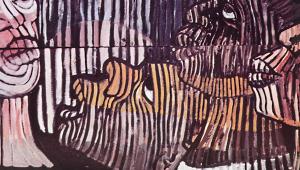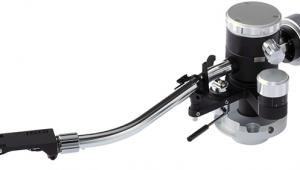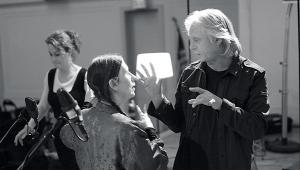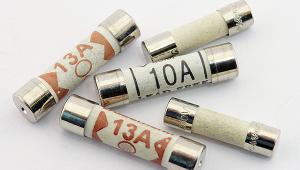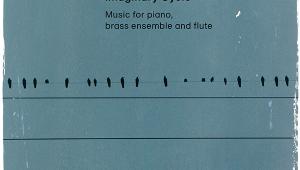Audia Flight Pre/50 (£3500/£4000)
There is something about the Italian high-end that gets my juices flowing. It’s the style, the grace, the sheer passion that goes into the design – and the absolute certainty that there will flaws of epic, forehead slapping proportion. Exhibit A – the Audia Flight Pre remote control. Utterly gorgeous, CNC-machined from an aluminium billet and offering an innovative multifunction interface that keeps the button count to a luxurious minimum. Flip it over and the brushed aluminium base plate sits on four feet – well, ultra-cheap stick-on plastic blobs that you can buy from B&Q in a sheet of a thousand for sixpence. Clearly ‘don’t spoil the ship for a hapeth of tar’ doesn’t translate into Italian.
The Flight Pre is a beautifully crafted piece of equipment, exuding high-end kudos with its 25mm thick milled aluminium fascia and subtle blue lighting. It’s a dual-mono, balanced design with microprocessor control affording such trick features such as individual input gain and the ability to name each source. Connectivity is excellent with twin sets of balanced XLR inputs and an array of solid-feeling RCAs for in, out, record and monitor.
COME THE REVOLUTION
The operation is a little quirky as you set the mode (source/volume/balance etc) and then use the main fascia knob or remote’s +/- keys to adjust accordingly. On the downside, switch to a source with the volume racked up high and you have to wait five seconds before the main knob becomes a volume control again to turn it down. Favourite flaw is the volume knob itself – requiring an hilarious 17 (yes, seventeen) complete revolutions from minimum to maximum volume.
In the same way you might not be too concerned with the fuel consumption of a high-end Italian sports car, potential purchasers of the Flight 50 may not be too bothered by its thirst for electricity. Those heat-sinking fins are not just for show as the fully balanced, dual mono, pure Class A operation creates a 30kg radiator when it’s idling. If you do suffer a little carbon-footprint guilt conscience, console your greener self that you didn’t buy its bigger brother, the Flight 100 – that draws twice as much power from the wall.
SHORT TROUSERS
A quick listen to the Audia pair from stone cold confirmed that letting them warm-up and stabilise is essential. Having forgotten to turn the central heating off in the music room, the combined thermal output meant the next day’s review was conducted in boxer shorts – unusual for November I grant you. This summer Sunday afternoon feel continued with the Flight’s warm balance and easy-going bass creating a supremely relaxed and enjoyable sound. The pair simply revels in enveloping you in the music, trading sheer width and depth of soundstage for more encapsulating and arguably more image-focused performance.
From the first few tracks you can tell this duo is more about flavour than perfect neutrality. Van Morrison’s ‘Tupelo Honey’ is richly portrayed with Van’s edgy vocal precisely centre stage and the smooth sax lifting nicely out of the mix. The piano is a little more recessed than ideal, lacking a really percussive edge even towards the end of the track when the playing is aggressive. Conversely this seems to allow the piano notes to better gel with the other instruments, creating a very cohesive overall experience. The bass line is presented well back in the mix and has an almost tube-amp like character, fluid but a little slow. As a whole, I was warming to the Flight system for its musicality but there simply wasn’t the bottom-end transparency or micro-detailing one expects of £7500 worth of amplification.
The Audia’s claimed 50W wasn’t looking good for a serious (loud) listening session either. However, in a come back that would put The Who to shame, the duo really gets into its stride with the volume up above about the –15dB level. Supertramp’s ‘Better Days’ from Brother Where You Bound rips into the room with superb pace and lightning fast attack to each note. The track’s opening piano is nicely percussive and the bass is tight and deep, albeit not produced in the gratuitous quantities that more potent amps can muster. As the volume raises the Audia system seems to shed its rather sedate demeanour in favour of one with altogether more punch and pace.
WINDING THE WICK
And it is not just rock and pop music to which giving the volume knob a turn (or ten) works wonders. Vivaldi’s Concerto in C for Two Trumpets sears into the room with solidity and good forward projection of the main instruments. The distinct character of each trumpet is revealed with ease and there is fine precision in the tonal detailing and the way the notes carry in the venue. Again the bass is on the light side for my tastes, even using 12in Tannoy floorstanders, but you can’t fault how deep it actually digs. The Timpani Crescendo in this 1984 Philharmonia Orchestra recording rolls out like distant thunder with a low reverb that not so much decays as disappears into the sub-sonic region.
The combination’s supremely low noise floor further improves the dynamic scale but you are patently aware that it is only a 50-Watter when the going gets tough at high volume. In an ideal world it would have bass power to flap your trousers – and run cool enough that you could wear trousers to flap.
VERDICT
Sumptuously designed and engineered, the Audia Flight pre/power constantly reminds you the high-end is a quirky place to be. Musical, intense and involving, its pace and timing improves with every dB until you have used all 50 Class A watts. Not the most transparent or thunderous amplifier, but blessed with a unique blend of addictive strengths and flavours.
Originally published in the January 2010 issue




























